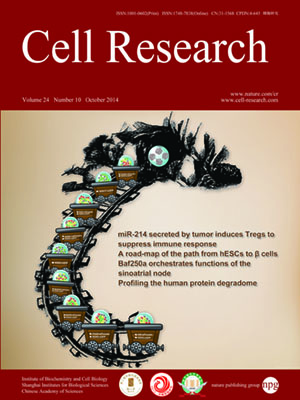
Volume 24, No 10, Oct 2014
ISSN: 1001-0602
EISSN: 1748-7838 2018
impact factor 17.848*
(Clarivate Analytics, 2019)
Volume 24 Issue 10, October 2014: 1266-1269 | Open Access
LETTERS TO THE EDITOR
Osteogenic fate of hypertrophic chondrocytes
Guan Yang1,*, Liang Zhu1,*, Ning Hou1, Yu Lan1, Xi-Mei Wu2, Bin Zhou3, Yan Teng1 and Xiao Yang1
1State Key Laboratory of Proteomics, Genetic Laboratory of Development and Diseases, Institute of Biotechnology, 20 Dongdajie, Beijing 100071
2Department of Pharmacology, School of Medicine, Zhejiang University, Hangzhou, Zhejiang 310058
3Key Laboratory of Nutrition and Metabolism, Institute for Nutritional Sciences, Shanghai Institutes for Biological Sciences, Graduate School of the Chinese Academy of Sciences, Chinese Academy of Sciences, Shanghai 200031, China
Correspondence: Guan Yang, Tel/Fax: 86-10-63895937 E-mail: yogopop3@163.com; Yan Teng, Tel/Fax: 86-10-63895937 E-mail: tengyan0919@163.com; Xiao Yang, Tel/Fax: 86-10-63895937(yangx@bmi.ac.cn)
Endochondral bone formation is largely dependent on cartilage lineage cells. The chondrocytes in growth plates continuously undergo a sequential process from proliferation to terminal hypertrophic differentiation1. Once differentiated, hypertrophic chondrocytes elicit multiple functions such as determining bone length, inducing osteogenesis as well as directing bone mineralization, and eventually disappear at the chondro-osseous junction. The fate of the terminally differentiated hypertrophic chondrocytes is conceptually important for understanding its role in endochondral bone formation. It has been debated for decades whether the terminally differentiated hypertrophic chondrocytes die by apoptosis or undergo osteogenic transdifferentiation, however, clear in vivo evidence is lacking2. Here, through lineage tracing, we provide the first in vivo evidence that the terminally differentiated hypertrophic chondrocytes are a potent source of osteoblasts, and retain multi-lineage differentiation potential.
10.1038/cr.2014.111
FULL TEXT | PDF
Browse 1964


